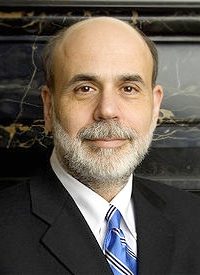
In his talk on Thursday to the Economic Club of Minneapolis, Federal Reserve Chairman Ben Bernanke (left) warned the Congressional Supercommittee not to cut government spending by too much, and that if the economy continues to slide into another recession, the Fed has tools to meet the challenge.
Speaking over the heads of his audience directly to the Supercommittee, Bernanke warned that “while prompt and decisive action to put the government’s finances on a sustainable trajectory is urgently needed, fiscal policymakers [i.e., you members of the Supercommittee] should not, as a consequence, disregard the fragility of the economic recovery.” In other words, it’s OK to do a little nibbling around the edges of government spending, but anything that would cut such spending seriously needs to be avoided altogether, at least until the economy gets back on its feet.
And that’s the problem. With the economy stalled, consumer spending slowing, factory production dropping, job growth at zero, 14 million Americans unemployed, jobless claims increasing, 42 million on food stamps, and consumer and investor confidence at its lowest levels in years, jumpstarting the economy is going to be a Herculean task even for the Fed.
The Fed has tools to deal with any further deterioration in the economy, said Bernanke, without being specific: “The Fed has a range of tools that could be used to provide additional monetary stimulus…[and the Federal Open Market Committee — the FOMC] are prepared to employ these tools as appropriate to promote a stronger economic recovery…” And they’re going to have two days, rather than the usual one day, to figure them out later this month.
Jonelle Marte, writing to investors about their options during this turmoil, says the Fed really only has two options under consideration: “Operation Twist,” and eliminating paying banks to keep their reserves at the Fed. “Operation Twist” is the strategy, never used before, to lower long term rates by reducing the Fed’s holdings of Treasury bills while increasing its holdings of long Treasury bonds. By buying longer term securities, the price of those securities would inevitably rise (so goes the theory), thus reducing interest rates on those securities (interest rates move opposite to bond prices). This would reduce the cost of long-term loans in the marketplace, such as 30-year fixed rate mortgages (already at historic lows), thus (the theory goes) making loans more attractive to debtors to get more in debt, which would stimulate the economy (or so the theory goes). But there are enough caveats and assumptions and abrogation of common sense in this flow of logic to frighten anyone, including Marte who says that at least one potential unintended consequence would be that bond investors who are looking for higher interest rates (yield) on their holdings would move to higher risk bonds that pay more. Or, as she put it, “Not only would you [then] have the credit risk of a junk bond, you now have a lower yielding piece of paper.”
The only other option the Fed has is eliminating paying interest to banks on funds held overnight at the Fed. Presently the 0.25% interest rate is more attractive to banks than to loan it out to credit-impaired borrowers who would be charged more, but might default. As Bill Gross, founder and co-chief investment officer for PIMCO, explains: “Borrowing short-term at a near risk-free rate and lending at a longer and riskier yield has been the basis of modern-day finance.” The problem is that, according to Gross, “Two-year yields are the same as overnight fund rates allowing for no incremental gain — a return that leveraged banks and lending institutions have based their income and expense budgets on. A bank can no longer borrow short and lend two years longer at a profit.” And that could force banks to look to lending to higher risk customers, thus putting their own stability at risk.
All of which is the natural result of massive and continuing interventions into the money markets which cause unintended consequences which then require additional massive interventions. Wash, rinse, repeat. The one option not being considered by Bernanke or his FOMC is the only option that has any chance of working: stop the meddling and experimenting. Withdraw from the market, send the reserves back to the banks, and close up shop. Let the market sort out the difficulties, which it would be happy to do if it knew that further meddling has ceased.



